What we think
We have a long track record of conducting applied research on business issues of relevance to senior executives. The outcomes nourish our conversations with executives and stimulate intelligent debate between them. Below are examples of recent articles and books in the fields of strategy and organization. You can download or order them.
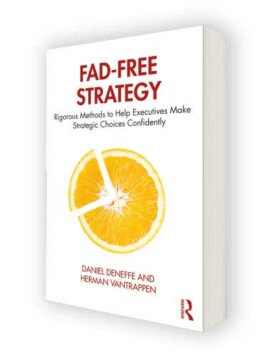
Fad-Free Strategy
Many strategy books suggest simplistic solutions to complicated problems. They offer rules based on anecdotal evidence pieced together from today’s hero companies, and they promise top line and margin growth to executives applying those rules. Unsurprisingly, many business strategies fail, despite great execution. “Fad-Free Strategy” provides a ground-breaking alternative. It recognizes that the choices that customers make rather than supposedly universal rules ultimately determine the success of a business strategy. It offers rigorous yet highly accessible economic tools to uncover hidden customer preferences. As a result, executives will be able to predict with confidence which strategic options will lead to commercial success.
Visit the Fad-Free Strategy website for more information: endorsements, Q&A, tutorials, reviews, articles, interviews and much more. You can order the book at Amazon or the publisher Routledge.
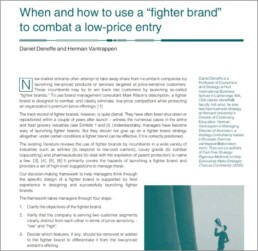
When and how to use a “fighter brand” to combat a low-price entry
Fighter brands are used by incumbents in response to new low-priced entrants targeting price-sensitive customers. Their track record, however, is quite dismal. The article describes a proven framework for designing effective fighter brands that take profitable share away from a new low-priced entrant without excessive cannibalization of the company’s flagship product.
Read the article published in Strategy & Leadership.
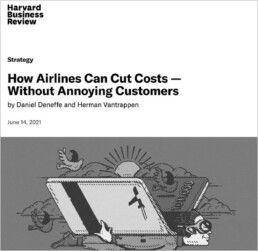
How Airlines Can Cut Costs — Without Annoying Customers
As behavioral economics research tells us, the effectiveness of traditional “a-la-carte pricing” practices, through which airlines charge passengers for all kinds of ancillary services, is limited. The “a-la-carte options” approach is better because it applies a reward-instead-of-penalize logic. The article explains how airlines can use frequent flyer miles to reduce those costs that are under their control without annoying customers.
Read the article published in the Harvard Business Review.
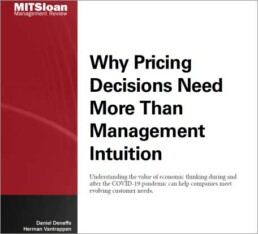
Why Pricing Decisions Need More Than Management Intuition
The COVID-19 pandemic has forced executives to question some of their long-held beliefs about the best way to deal with rapidly changing customer needs. The article describes six common challenges with regards to customer strategy and pricing, explains why the intuitive responses may not be that sensible after all, and suggests more thoughtful responses based on sound economic and strategic logic.
Read the article published in MIT Sloan Management Review.
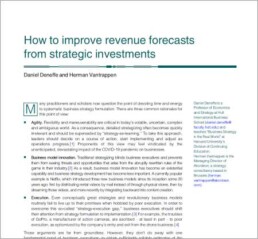
How to improve revenue forecasts from strategic investments
Obtaining reliable estimates of the likely revenues and profits from making a strategic move remains a critical management capability. The traditional methods for doing so are simply inadequate. The article presents a proven approach based on an in-depth understanding of differences in customer preferences and willingness-to-pay.
Read the article published in Strategy & Leadership.
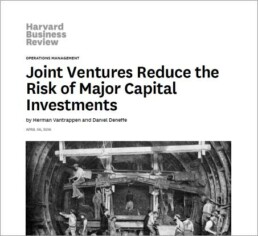
Joint Ventures Reduce the Risk of Major Capital Investments
When economic growth is slow and investments costs are rising, even cash-rich companies understandably tend to put a brake on the addition or renewal of production capacity. Yet by doing so, they risk lagging behind competitors when good times return. The article presents seven alternative asset ownership & operation models to escape from this dilemma.
Read the article published in the Harvard Business Review.
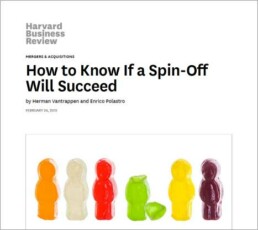
How to Know If a Spin-Off Will Succeed
There are enormous differences in the performance of businesses after divestment, be it as a standalone company or under the stewardship of a new parent. While exogenous factors explain some differences, there are also factors that the divested business’s (new) management and new owners do control. This article presents four questions for prospective new owners. They should invest in the spin-off only if they are comfortable with the answers.
Read the article published in the Harvard Business Review.
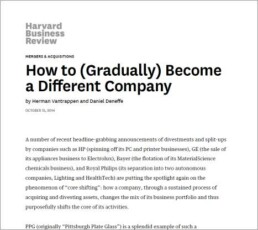
How to gradually become a different company
“Core shifting” is about how a company, through a sustained process of acquiring and divesting assets, changes the mix of its business portfolio and thus purposefully shifts the core of its activities. This article explains what it takes to pull off a core shift successfully: tenacity, vision, boldness, transparency, and results-orientation.
Read the article published in the Harvard Business Review.
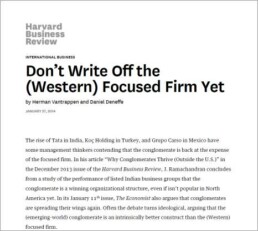
Don’t Write Off the (Western) Focused Firm Yet
The success of emerging-market conglomerates such as Tata makes some business thinkers claim that the traditional Western focused firm is a doomed business construct. This article argues that a conglomerate may thrive in environments with a large public accountability deficit, but that otherwise the focused firm has a clear advantage. It is all about some simple micro-economics.
Read the article published in the Harvard Business Review.
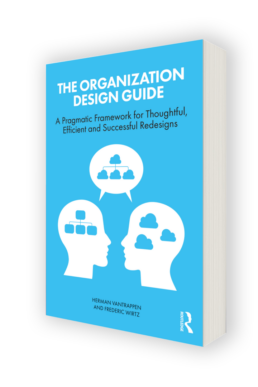
The Organization Design Guide
“The Organization Design Guide” provides a comprehensive framework enabling executives and their teams to have nuanced, in-depth and conclusive discussions about hard organization design choices. The book steers clear of academic abstractions, simplistic formulaic solutions, flavor-of-the-year debates and misleading anecdotes from today’s superstar firms. It is written for smart executives at mainstream companies who realize that organization design choices are contextual and influenced by their company’s specific history. The book will also appeal to board directors, senior and middle managers, internal project leaders, organization design consultants and anybody else leading or supervising an organization redesign exercise.
Visit the Organization Design Guide website for more information: endorsements, Q&A, tutorials, articles and much more. You can order the book at Amazon or the publisher Routledge.
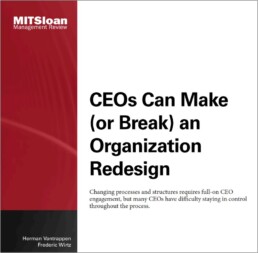
CEOs Can Make (or Break) an Organization Redesign
Organization redesigns consume significant time, resources, and emotional energy. The article provides a thoughtful and pragmatic design framework to guide executives throughout the process. It also shows how CEOs should start the process with some honest introspection about their own behavioral tendencies and vulnerabilities, and what actions they can take to prevent the redesign exercise from derailing.
Read the article published in MIT Sloan Management Review.
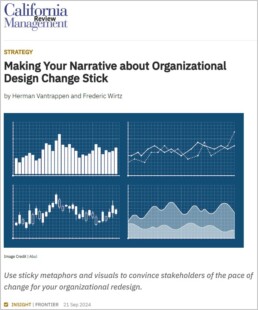
Making Your Narrative about Organizational Design Change Stick
When initiating an organizational redesign, you expect your people to buy into the change. But they will only do so if they understand and remember what you have in mind. To get there, it helps to communicate using sticky metaphors. The article presents five metaphors useful to explain your chosen pace of change: its magnitude (from incremental to radical), frequency (from continually to rarely), and timing (from proactive to reactive).
Read the article published in California Management Review.
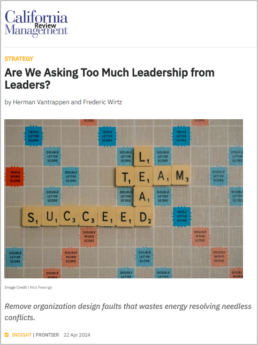
Are We Asking Too Much Leadership from Leaders?
Senior leaders often have to activate commendable leadership behaviors (authenticity, empathy, etc.) to resolve internal conflicts that should not have escalated to the top. The article shows that the emergence and escalation of such conflicts may be due to organization design faults and ambiguities that magnify everyday tensions and frictions. By identifying and removing these faults and ambiguities, the opportunity cost of senior leaders devoting energy and time to resolving preventable conflicts would be much lower.
Read the article published in California Management Review.
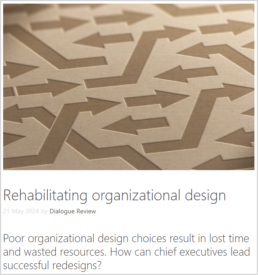
Rehabilitating Organizational Design
A clear purpose, careful change and exemplary leadership are undeniably essential to a company’s success. But truly effective CEOs go beyond those basics: They also demand craftsmanship in organizational design; they care for nuance in organizational design discussions; and they engage personally in the organizational redesign exercise from A to Z. Eventually, organizational design is all about people.
Read the article published in Dialogue Review.
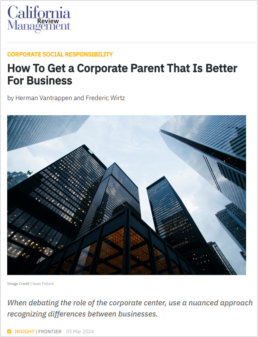
How To Get a Corporate Parent That Is Better For Business
The debate about the role of a company’s corporate parent (aka “HQ” or “center”) is often formulated in terms of either “more parent” or “less parent”, thereby using artificial archetypes. The article shows that the debate should be about getting a “better parent”. It presents a nuanced approach that recognizes the specific ways in which the corporate parent could influence the day-to-day functioning of the diverse businesses in its portfolio.
Read the article published in California Management Review.
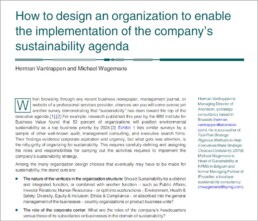
How to design an organization to enable the implementation of the company’s sustainability agenda
“Sustainability” has risen to the top of the executive agenda. What gets less attention, is the nitty-gritty of organizing for sustainability and assigning roles and responsibilities. The article offers a framework to make those design choices, starting from two considerations: the substantive focus of the company’s sustainability agenda, and the principles by which the company is organized in general.
Read the article published in Strategy & Leadership.

When to Change Your Company’s P&L Responsibilities
Changing an organization’s primary dimension, i.e., making a different choice of which verticals have full P&L responsibility, is not something to get into lightly. The article provides answers to the two key questions executives should ask when considering a major rearrangement. First, when has the time come to change our primary dimension? Second, once we have decided to change, how fast should we go?
Read the article published in the Harvard Business Review.
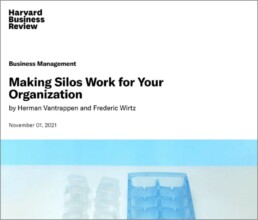
Making Silos Work for Your Organization
Incitements to “bust the silos” within organizations are quite popular. Silos (or “verticals”) indeed have undesirable side effects such as insular mindsets and turf wars. But they exist for good reasons: to aggregate expertise, assign accountability, and provide a sense of identity. The article explains how to preserve the strengths of the inescapable verticals while minimizing their side effects: build bridges between verticals and institute checks and balances.
Read the article published in the Harvard Business Review. The article is also part of the HBR Guide to Executing Your Strategy.
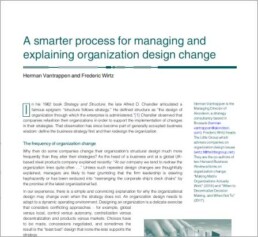
A smarter process for managing and explaining organization design change
An organization design is never perfect – but at some point you’ve got to decide and go for the “least bad” design. Afterwards you continually add checks and balances to make up for the imperfections, until your organization gets completely unwieldy and triggers a wholesale redesign. The article presents guidelines for explaining and managing this inescapable cycle, and thus preventing cynicism about “yet another organization change”.
Read the article published in Strategy & Leadership.
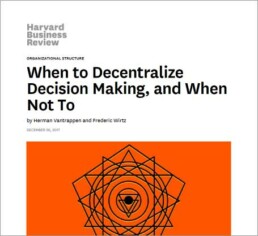
When to Decentralize Decision Making, and When Not To
Debates about centralization vs. decentralization are often fraught with emotion and protectiveness. On the one hand, business responsiveness calls for decentralization of decision-making to the operating units. On the other hand, concerns about business reliability, efficiency and perennity may pull the other way. The article presents a proven way of thinking to help rationalize that debate.
Read the article published in the Harvard Business Review. The article is also part of the HBR Special Issue “How to Make Decisions Amid Chaos”.
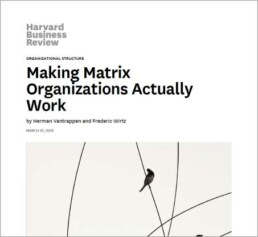
Making Matrix Organizations Actually Work
A matrix is a tool to strengthen lateral coordination. When deployed sparingly and wisely, a matrix can improve the quality and speed of decision-making without obfuscating accountability. The article briefly describes five guidelines for doing so. The goal is to gain enough trust in the matrix to let it do its work, sensing the matrix is there without noticing it.
Read the article published in the Harvard Business Review.
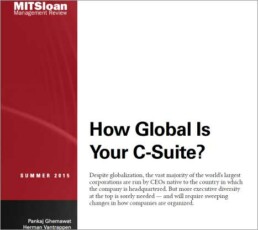
How Global Is Your C-Suite?
By analyzing the prevalence of non-native CEOs at the largest global companies, the article indicates what companies can do to attract diverse management talent from outside their home country. By the same token, it informs aspiring managers about the data they should gather to identify companies outside their home country offering the most promising career prospects.
Read the article published in MIT Sloan Management Review or excerpts in Fortune, Harvard Business Review (x2), Nikkei Asian Review or Economist.
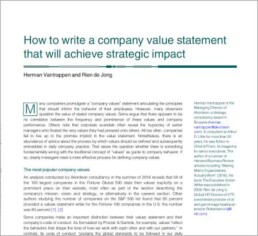
How to write a company value statement that will achieve strategic impact
Stated values at most companies fail to have much of an impact: they don’t boost performance, they don’t set the company apart, and they don’t steer employee behavior. That is because they are defined as generic, non-negotiable points of perfection. The article presents a novel approach that leads to values that do reveal and reinforce the company’s distinct and desired culture.
Read the article published in Strategy & Leadership.

The Executive Action Writer
Borrowing insights from social psychology and behavioral economics, the author advises businesspeople how to craft texts that will evoke the response they want from their target readers. Think of a presentation to your Board, a letter to a prospective client, a one-page memo to your boss, an e-mail to a colleague or any other business text written to persuade your reader to take the action required.
Watch a short video clip, read a summary with 7 tips in Fortune, or order the book directly at Amazon.